MKT00720 - Marketing Strategies and Competitive Advantage Report
VerifiedAdded on 2022/10/12
|10
|2330
|250
Report
AI Summary
This report analyzes the marketing strategies of Nike and Google, focusing on how these organizations achieve and maintain a competitive advantage in their respective markets. The introduction provides an overview of marketing concepts and the importance of marketing mix. The report then delves into case studies of Nike and Google, examining their marketing processes, including market segmentation, pricing strategies, and promotional activities. The analysis utilizes the Ansoff matrix and SWOT analysis to evaluate the effectiveness of their approaches. The report highlights how Nike leverages innovation, brand equity, and a global presence, while Google emphasizes product innovation, low-cost services, and broad market targeting. The conclusion emphasizes the significance of marketing strategies in achieving business success and competitive advantages. It also summarizes the key findings and the marketing concepts and theories used by the companies.
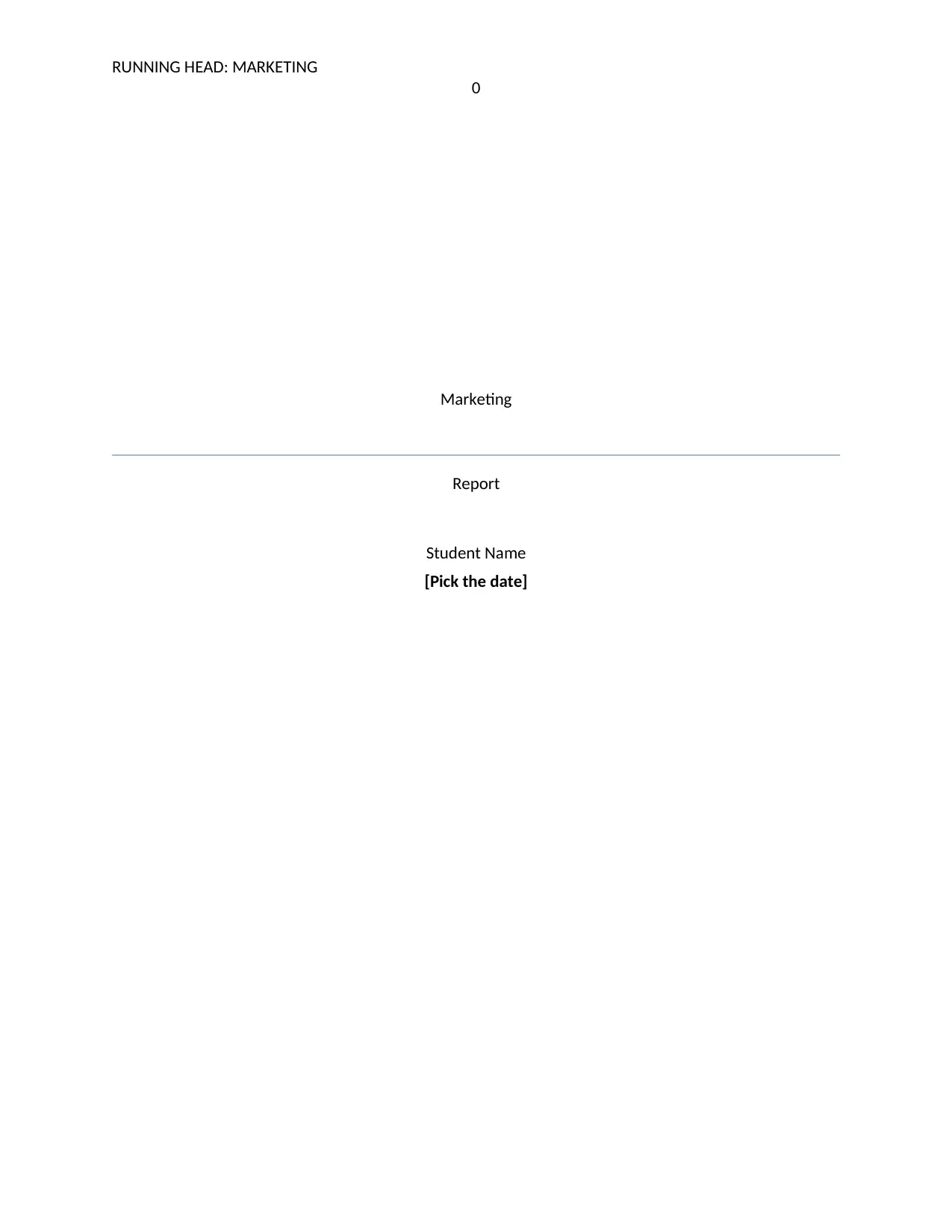
RUNNING HEAD: MARKETING
0
Marketing
Report
Student Name
[Pick the date]
0
Marketing
Report
Student Name
[Pick the date]
Paraphrase This Document
Need a fresh take? Get an instant paraphrase of this document with our AI Paraphraser
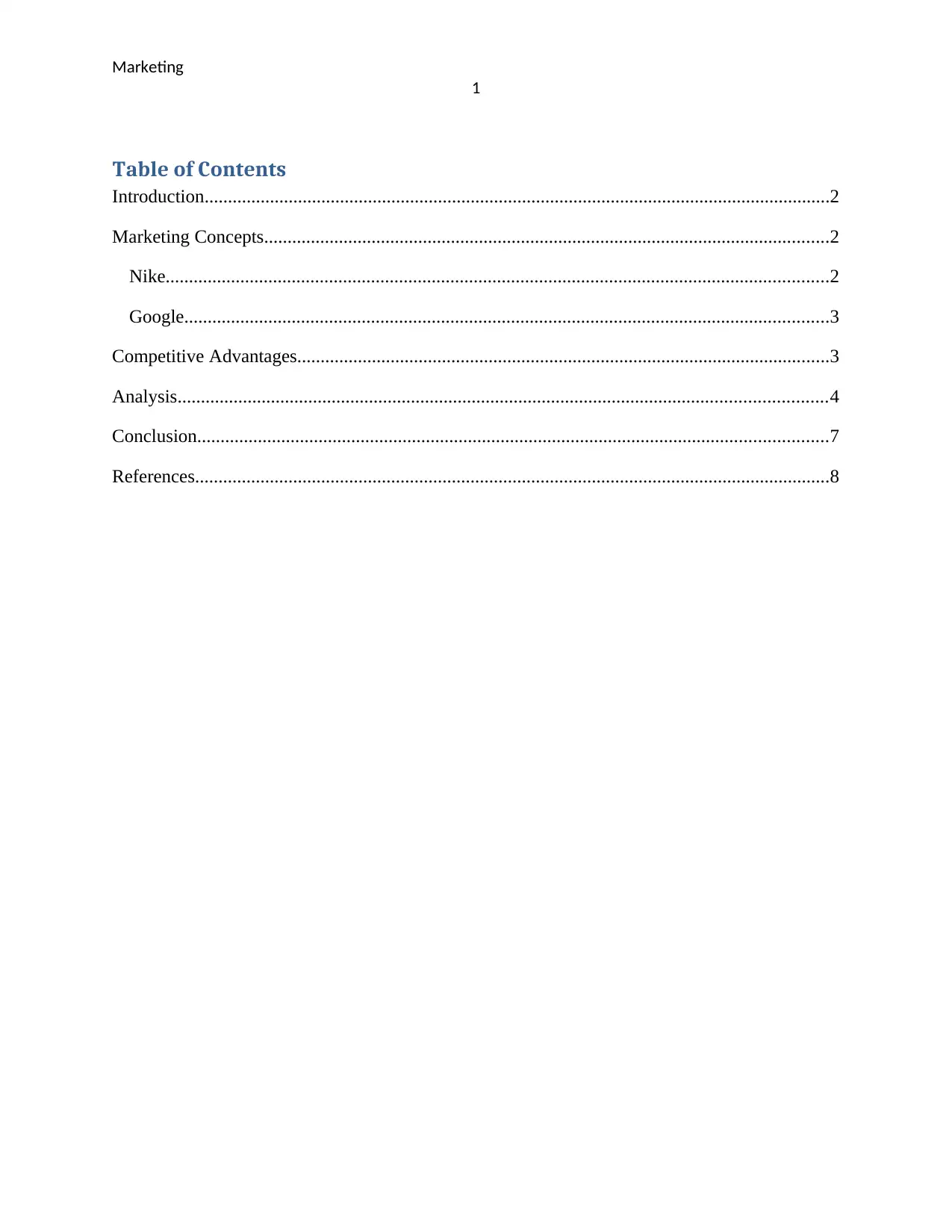
Marketing
1
Table of Contents
Introduction......................................................................................................................................2
Marketing Concepts.........................................................................................................................2
Nike..............................................................................................................................................2
Google..........................................................................................................................................3
Competitive Advantages..................................................................................................................3
Analysis...........................................................................................................................................4
Conclusion.......................................................................................................................................7
References........................................................................................................................................8
1
Table of Contents
Introduction......................................................................................................................................2
Marketing Concepts.........................................................................................................................2
Nike..............................................................................................................................................2
Google..........................................................................................................................................3
Competitive Advantages..................................................................................................................3
Analysis...........................................................................................................................................4
Conclusion.......................................................................................................................................7
References........................................................................................................................................8
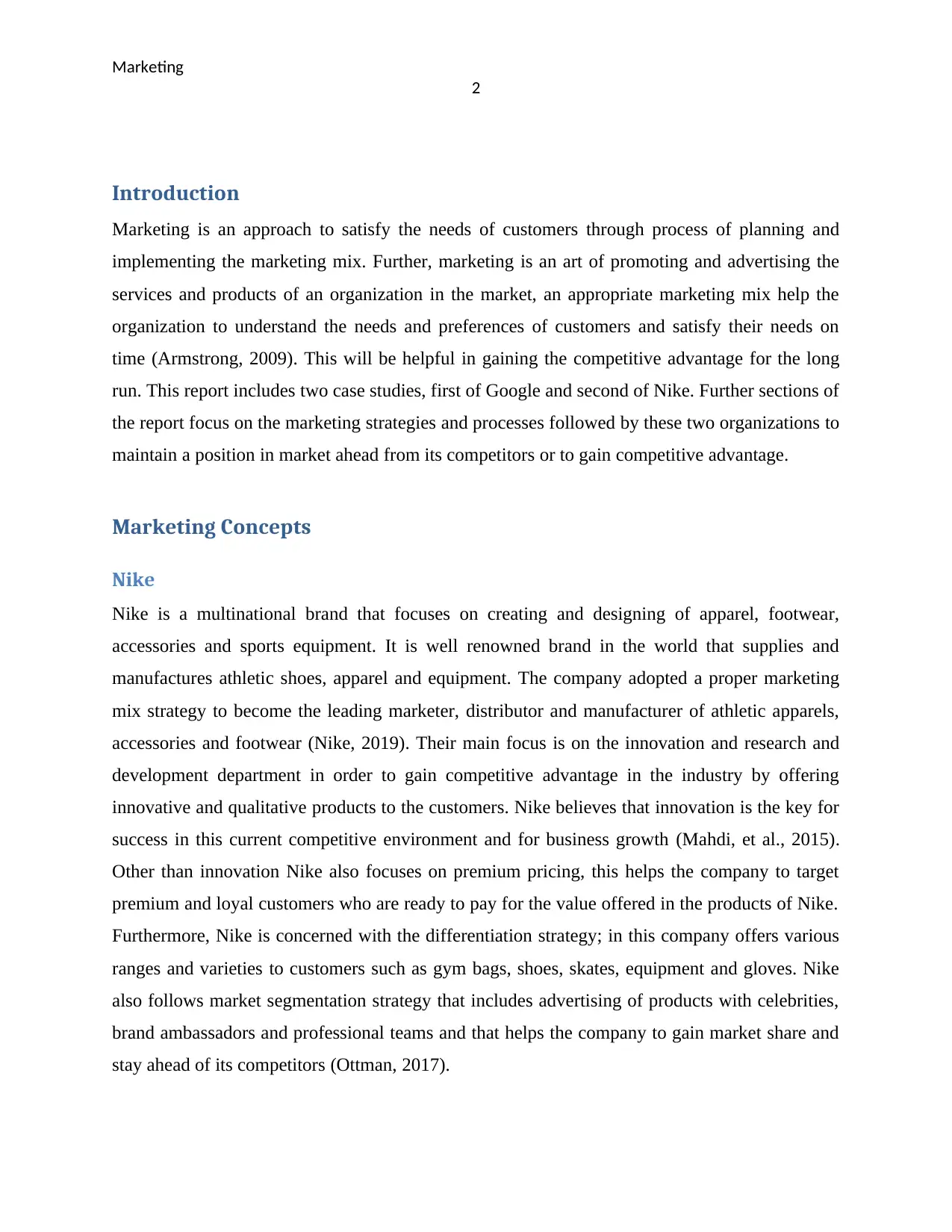
Marketing
2
Introduction
Marketing is an approach to satisfy the needs of customers through process of planning and
implementing the marketing mix. Further, marketing is an art of promoting and advertising the
services and products of an organization in the market, an appropriate marketing mix help the
organization to understand the needs and preferences of customers and satisfy their needs on
time (Armstrong, 2009). This will be helpful in gaining the competitive advantage for the long
run. This report includes two case studies, first of Google and second of Nike. Further sections of
the report focus on the marketing strategies and processes followed by these two organizations to
maintain a position in market ahead from its competitors or to gain competitive advantage.
Marketing Concepts
Nike
Nike is a multinational brand that focuses on creating and designing of apparel, footwear,
accessories and sports equipment. It is well renowned brand in the world that supplies and
manufactures athletic shoes, apparel and equipment. The company adopted a proper marketing
mix strategy to become the leading marketer, distributor and manufacturer of athletic apparels,
accessories and footwear (Nike, 2019). Their main focus is on the innovation and research and
development department in order to gain competitive advantage in the industry by offering
innovative and qualitative products to the customers. Nike believes that innovation is the key for
success in this current competitive environment and for business growth (Mahdi, et al., 2015).
Other than innovation Nike also focuses on premium pricing, this helps the company to target
premium and loyal customers who are ready to pay for the value offered in the products of Nike.
Furthermore, Nike is concerned with the differentiation strategy; in this company offers various
ranges and varieties to customers such as gym bags, shoes, skates, equipment and gloves. Nike
also follows market segmentation strategy that includes advertising of products with celebrities,
brand ambassadors and professional teams and that helps the company to gain market share and
stay ahead of its competitors (Ottman, 2017).
2
Introduction
Marketing is an approach to satisfy the needs of customers through process of planning and
implementing the marketing mix. Further, marketing is an art of promoting and advertising the
services and products of an organization in the market, an appropriate marketing mix help the
organization to understand the needs and preferences of customers and satisfy their needs on
time (Armstrong, 2009). This will be helpful in gaining the competitive advantage for the long
run. This report includes two case studies, first of Google and second of Nike. Further sections of
the report focus on the marketing strategies and processes followed by these two organizations to
maintain a position in market ahead from its competitors or to gain competitive advantage.
Marketing Concepts
Nike
Nike is a multinational brand that focuses on creating and designing of apparel, footwear,
accessories and sports equipment. It is well renowned brand in the world that supplies and
manufactures athletic shoes, apparel and equipment. The company adopted a proper marketing
mix strategy to become the leading marketer, distributor and manufacturer of athletic apparels,
accessories and footwear (Nike, 2019). Their main focus is on the innovation and research and
development department in order to gain competitive advantage in the industry by offering
innovative and qualitative products to the customers. Nike believes that innovation is the key for
success in this current competitive environment and for business growth (Mahdi, et al., 2015).
Other than innovation Nike also focuses on premium pricing, this helps the company to target
premium and loyal customers who are ready to pay for the value offered in the products of Nike.
Furthermore, Nike is concerned with the differentiation strategy; in this company offers various
ranges and varieties to customers such as gym bags, shoes, skates, equipment and gloves. Nike
also follows market segmentation strategy that includes advertising of products with celebrities,
brand ambassadors and professional teams and that helps the company to gain market share and
stay ahead of its competitors (Ottman, 2017).
⊘ This is a preview!⊘
Do you want full access?
Subscribe today to unlock all pages.

Trusted by 1+ million students worldwide
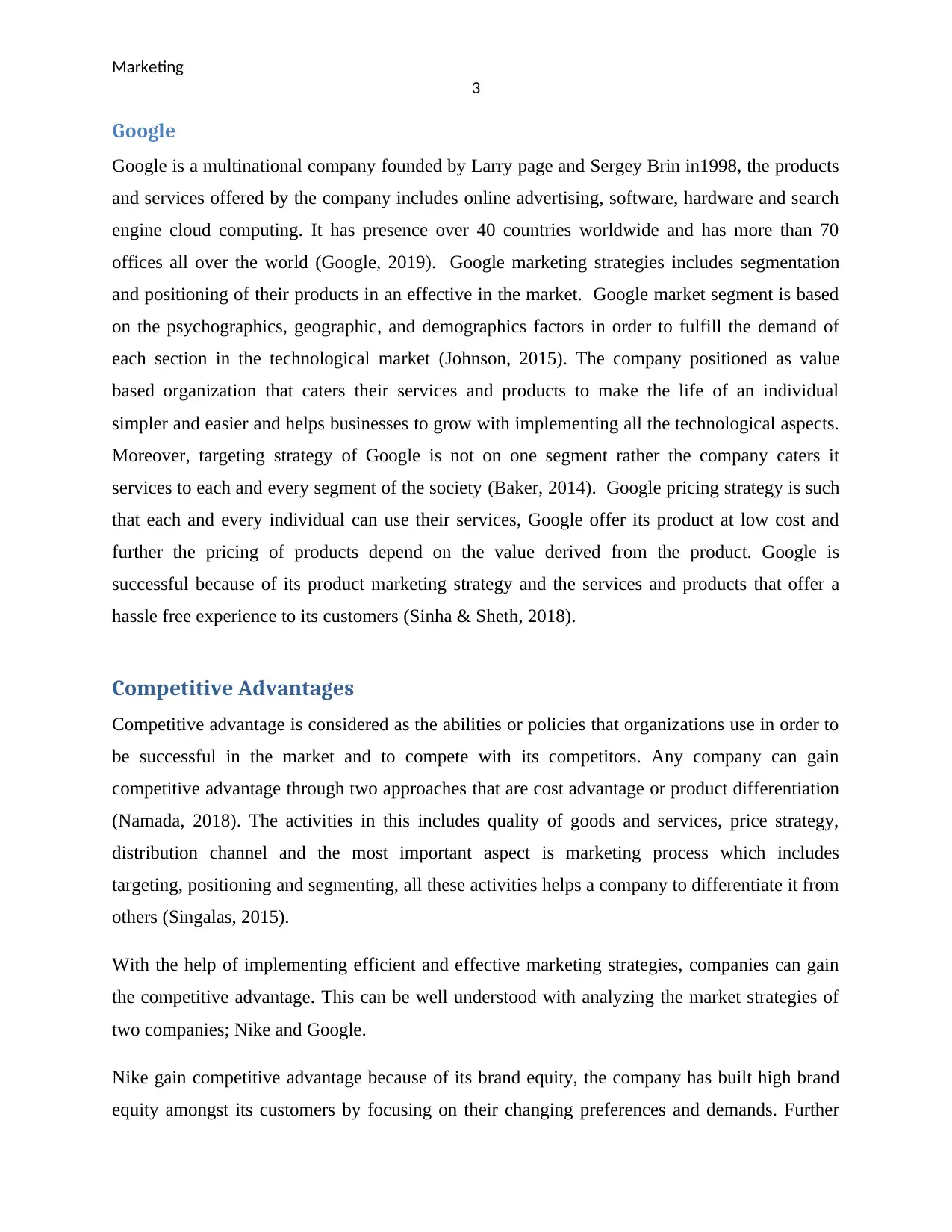
Marketing
3
Google
Google is a multinational company founded by Larry page and Sergey Brin in1998, the products
and services offered by the company includes online advertising, software, hardware and search
engine cloud computing. It has presence over 40 countries worldwide and has more than 70
offices all over the world (Google, 2019). Google marketing strategies includes segmentation
and positioning of their products in an effective in the market. Google market segment is based
on the psychographics, geographic, and demographics factors in order to fulfill the demand of
each section in the technological market (Johnson, 2015). The company positioned as value
based organization that caters their services and products to make the life of an individual
simpler and easier and helps businesses to grow with implementing all the technological aspects.
Moreover, targeting strategy of Google is not on one segment rather the company caters it
services to each and every segment of the society (Baker, 2014). Google pricing strategy is such
that each and every individual can use their services, Google offer its product at low cost and
further the pricing of products depend on the value derived from the product. Google is
successful because of its product marketing strategy and the services and products that offer a
hassle free experience to its customers (Sinha & Sheth, 2018).
Competitive Advantages
Competitive advantage is considered as the abilities or policies that organizations use in order to
be successful in the market and to compete with its competitors. Any company can gain
competitive advantage through two approaches that are cost advantage or product differentiation
(Namada, 2018). The activities in this includes quality of goods and services, price strategy,
distribution channel and the most important aspect is marketing process which includes
targeting, positioning and segmenting, all these activities helps a company to differentiate it from
others (Singalas, 2015).
With the help of implementing efficient and effective marketing strategies, companies can gain
the competitive advantage. This can be well understood with analyzing the market strategies of
two companies; Nike and Google.
Nike gain competitive advantage because of its brand equity, the company has built high brand
equity amongst its customers by focusing on their changing preferences and demands. Further
3
Google is a multinational company founded by Larry page and Sergey Brin in1998, the products
and services offered by the company includes online advertising, software, hardware and search
engine cloud computing. It has presence over 40 countries worldwide and has more than 70
offices all over the world (Google, 2019). Google marketing strategies includes segmentation
and positioning of their products in an effective in the market. Google market segment is based
on the psychographics, geographic, and demographics factors in order to fulfill the demand of
each section in the technological market (Johnson, 2015). The company positioned as value
based organization that caters their services and products to make the life of an individual
simpler and easier and helps businesses to grow with implementing all the technological aspects.
Moreover, targeting strategy of Google is not on one segment rather the company caters it
services to each and every segment of the society (Baker, 2014). Google pricing strategy is such
that each and every individual can use their services, Google offer its product at low cost and
further the pricing of products depend on the value derived from the product. Google is
successful because of its product marketing strategy and the services and products that offer a
hassle free experience to its customers (Sinha & Sheth, 2018).
Competitive Advantages
Competitive advantage is considered as the abilities or policies that organizations use in order to
be successful in the market and to compete with its competitors. Any company can gain
competitive advantage through two approaches that are cost advantage or product differentiation
(Namada, 2018). The activities in this includes quality of goods and services, price strategy,
distribution channel and the most important aspect is marketing process which includes
targeting, positioning and segmenting, all these activities helps a company to differentiate it from
others (Singalas, 2015).
With the help of implementing efficient and effective marketing strategies, companies can gain
the competitive advantage. This can be well understood with analyzing the market strategies of
two companies; Nike and Google.
Nike gain competitive advantage because of its brand equity, the company has built high brand
equity amongst its customers by focusing on their changing preferences and demands. Further
Paraphrase This Document
Need a fresh take? Get an instant paraphrase of this document with our AI Paraphraser
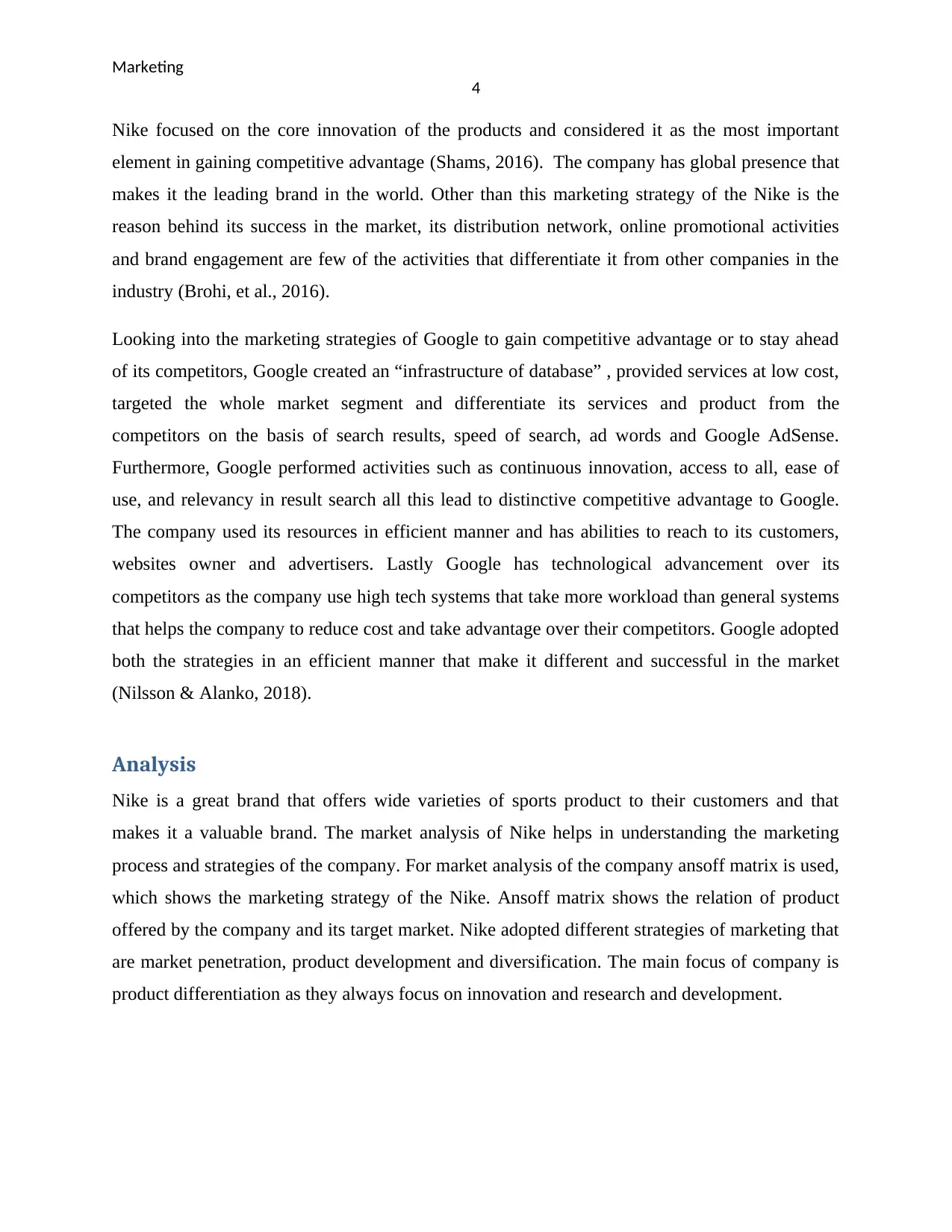
Marketing
4
Nike focused on the core innovation of the products and considered it as the most important
element in gaining competitive advantage (Shams, 2016). The company has global presence that
makes it the leading brand in the world. Other than this marketing strategy of the Nike is the
reason behind its success in the market, its distribution network, online promotional activities
and brand engagement are few of the activities that differentiate it from other companies in the
industry (Brohi, et al., 2016).
Looking into the marketing strategies of Google to gain competitive advantage or to stay ahead
of its competitors, Google created an “infrastructure of database” , provided services at low cost,
targeted the whole market segment and differentiate its services and product from the
competitors on the basis of search results, speed of search, ad words and Google AdSense.
Furthermore, Google performed activities such as continuous innovation, access to all, ease of
use, and relevancy in result search all this lead to distinctive competitive advantage to Google.
The company used its resources in efficient manner and has abilities to reach to its customers,
websites owner and advertisers. Lastly Google has technological advancement over its
competitors as the company use high tech systems that take more workload than general systems
that helps the company to reduce cost and take advantage over their competitors. Google adopted
both the strategies in an efficient manner that make it different and successful in the market
(Nilsson & Alanko, 2018).
Analysis
Nike is a great brand that offers wide varieties of sports product to their customers and that
makes it a valuable brand. The market analysis of Nike helps in understanding the marketing
process and strategies of the company. For market analysis of the company ansoff matrix is used,
which shows the marketing strategy of the Nike. Ansoff matrix shows the relation of product
offered by the company and its target market. Nike adopted different strategies of marketing that
are market penetration, product development and diversification. The main focus of company is
product differentiation as they always focus on innovation and research and development.
4
Nike focused on the core innovation of the products and considered it as the most important
element in gaining competitive advantage (Shams, 2016). The company has global presence that
makes it the leading brand in the world. Other than this marketing strategy of the Nike is the
reason behind its success in the market, its distribution network, online promotional activities
and brand engagement are few of the activities that differentiate it from other companies in the
industry (Brohi, et al., 2016).
Looking into the marketing strategies of Google to gain competitive advantage or to stay ahead
of its competitors, Google created an “infrastructure of database” , provided services at low cost,
targeted the whole market segment and differentiate its services and product from the
competitors on the basis of search results, speed of search, ad words and Google AdSense.
Furthermore, Google performed activities such as continuous innovation, access to all, ease of
use, and relevancy in result search all this lead to distinctive competitive advantage to Google.
The company used its resources in efficient manner and has abilities to reach to its customers,
websites owner and advertisers. Lastly Google has technological advancement over its
competitors as the company use high tech systems that take more workload than general systems
that helps the company to reduce cost and take advantage over their competitors. Google adopted
both the strategies in an efficient manner that make it different and successful in the market
(Nilsson & Alanko, 2018).
Analysis
Nike is a great brand that offers wide varieties of sports product to their customers and that
makes it a valuable brand. The market analysis of Nike helps in understanding the marketing
process and strategies of the company. For market analysis of the company ansoff matrix is used,
which shows the marketing strategy of the Nike. Ansoff matrix shows the relation of product
offered by the company and its target market. Nike adopted different strategies of marketing that
are market penetration, product development and diversification. The main focus of company is
product differentiation as they always focus on innovation and research and development.
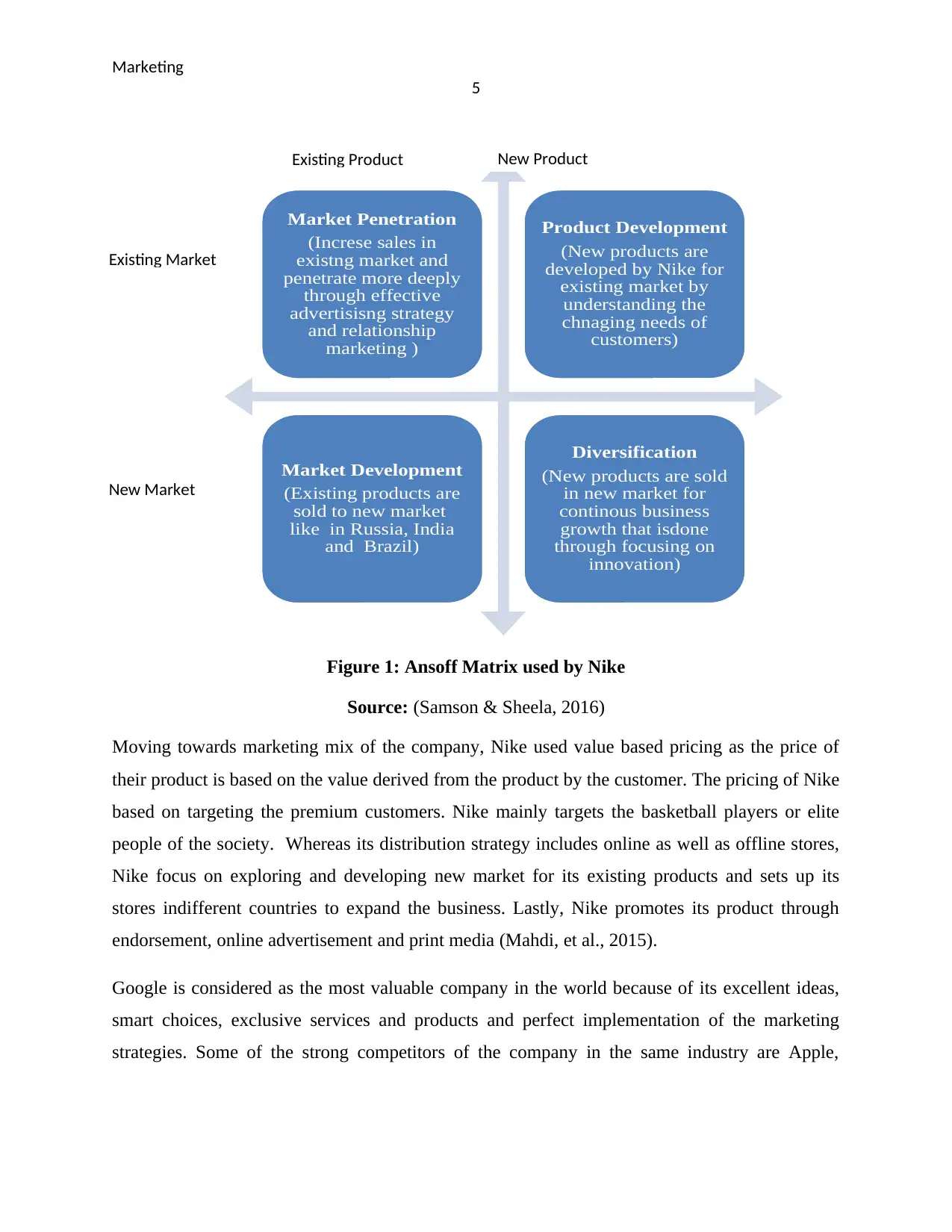
Marketing
5
Figure 1: Ansoff Matrix used by Nike
Source: (Samson & Sheela, 2016)
Moving towards marketing mix of the company, Nike used value based pricing as the price of
their product is based on the value derived from the product by the customer. The pricing of Nike
based on targeting the premium customers. Nike mainly targets the basketball players or elite
people of the society. Whereas its distribution strategy includes online as well as offline stores,
Nike focus on exploring and developing new market for its existing products and sets up its
stores indifferent countries to expand the business. Lastly, Nike promotes its product through
endorsement, online advertisement and print media (Mahdi, et al., 2015).
Google is considered as the most valuable company in the world because of its excellent ideas,
smart choices, exclusive services and products and perfect implementation of the marketing
strategies. Some of the strong competitors of the company in the same industry are Apple,
Market Penetration
(Increse sales in
existng market and
penetrate more deeply
through effective
advertisisng strategy
and relationship
marketing )
Product Development
(New products are
developed by Nike for
existing market by
understanding the
chnaging needs of
customers)
Market Development
(Existing products are
sold to new market
like in Russia, India
and Brazil)
Diversification
(New products are sold
in new market for
continous business
growth that isdone
through focusing on
innovation)
Existing Market
New Market
New ProductExisting Product
5
Figure 1: Ansoff Matrix used by Nike
Source: (Samson & Sheela, 2016)
Moving towards marketing mix of the company, Nike used value based pricing as the price of
their product is based on the value derived from the product by the customer. The pricing of Nike
based on targeting the premium customers. Nike mainly targets the basketball players or elite
people of the society. Whereas its distribution strategy includes online as well as offline stores,
Nike focus on exploring and developing new market for its existing products and sets up its
stores indifferent countries to expand the business. Lastly, Nike promotes its product through
endorsement, online advertisement and print media (Mahdi, et al., 2015).
Google is considered as the most valuable company in the world because of its excellent ideas,
smart choices, exclusive services and products and perfect implementation of the marketing
strategies. Some of the strong competitors of the company in the same industry are Apple,
Market Penetration
(Increse sales in
existng market and
penetrate more deeply
through effective
advertisisng strategy
and relationship
marketing )
Product Development
(New products are
developed by Nike for
existing market by
understanding the
chnaging needs of
customers)
Market Development
(Existing products are
sold to new market
like in Russia, India
and Brazil)
Diversification
(New products are sold
in new market for
continous business
growth that isdone
through focusing on
innovation)
Existing Market
New Market
New ProductExisting Product
⊘ This is a preview!⊘
Do you want full access?
Subscribe today to unlock all pages.

Trusted by 1+ million students worldwide
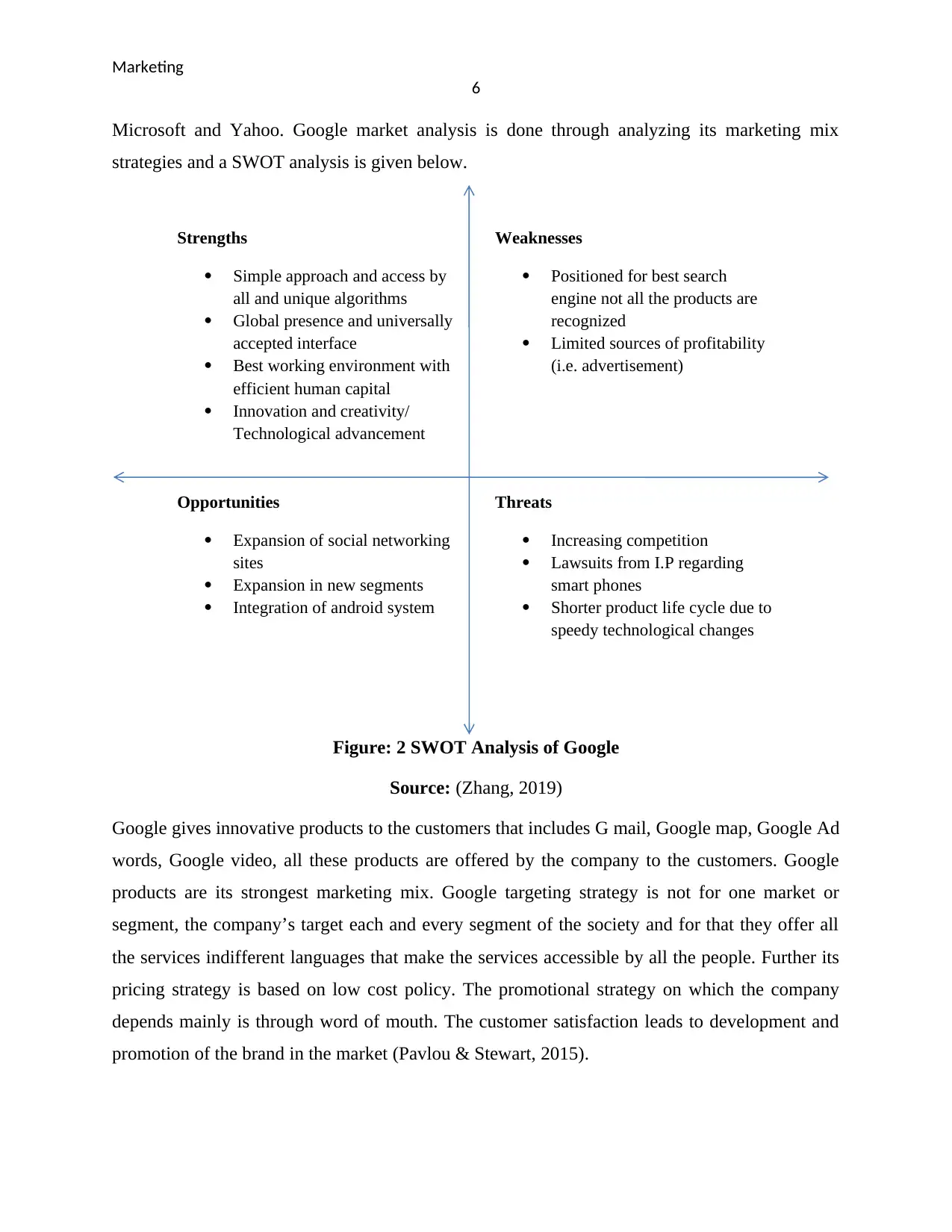
Marketing
6
Microsoft and Yahoo. Google market analysis is done through analyzing its marketing mix
strategies and a SWOT analysis is given below.
Figure: 2 SWOT Analysis of Google
Source: (Zhang, 2019)
Google gives innovative products to the customers that includes G mail, Google map, Google Ad
words, Google video, all these products are offered by the company to the customers. Google
products are its strongest marketing mix. Google targeting strategy is not for one market or
segment, the company’s target each and every segment of the society and for that they offer all
the services indifferent languages that make the services accessible by all the people. Further its
pricing strategy is based on low cost policy. The promotional strategy on which the company
depends mainly is through word of mouth. The customer satisfaction leads to development and
promotion of the brand in the market (Pavlou & Stewart, 2015).
Strengths
Simple approach and access by
all and unique algorithms
Global presence and universally
accepted interface
Best working environment with
efficient human capital
Innovation and creativity/
Technological advancement
Weaknesses
Positioned for best search
engine not all the products are
recognized
Limited sources of profitability
(i.e. advertisement)
Threats
Increasing competition
Lawsuits from I.P regarding
smart phones
Shorter product life cycle due to
speedy technological changes
Opportunities
Expansion of social networking
sites
Expansion in new segments
Integration of android system
6
Microsoft and Yahoo. Google market analysis is done through analyzing its marketing mix
strategies and a SWOT analysis is given below.
Figure: 2 SWOT Analysis of Google
Source: (Zhang, 2019)
Google gives innovative products to the customers that includes G mail, Google map, Google Ad
words, Google video, all these products are offered by the company to the customers. Google
products are its strongest marketing mix. Google targeting strategy is not for one market or
segment, the company’s target each and every segment of the society and for that they offer all
the services indifferent languages that make the services accessible by all the people. Further its
pricing strategy is based on low cost policy. The promotional strategy on which the company
depends mainly is through word of mouth. The customer satisfaction leads to development and
promotion of the brand in the market (Pavlou & Stewart, 2015).
Strengths
Simple approach and access by
all and unique algorithms
Global presence and universally
accepted interface
Best working environment with
efficient human capital
Innovation and creativity/
Technological advancement
Weaknesses
Positioned for best search
engine not all the products are
recognized
Limited sources of profitability
(i.e. advertisement)
Threats
Increasing competition
Lawsuits from I.P regarding
smart phones
Shorter product life cycle due to
speedy technological changes
Opportunities
Expansion of social networking
sites
Expansion in new segments
Integration of android system
Paraphrase This Document
Need a fresh take? Get an instant paraphrase of this document with our AI Paraphraser
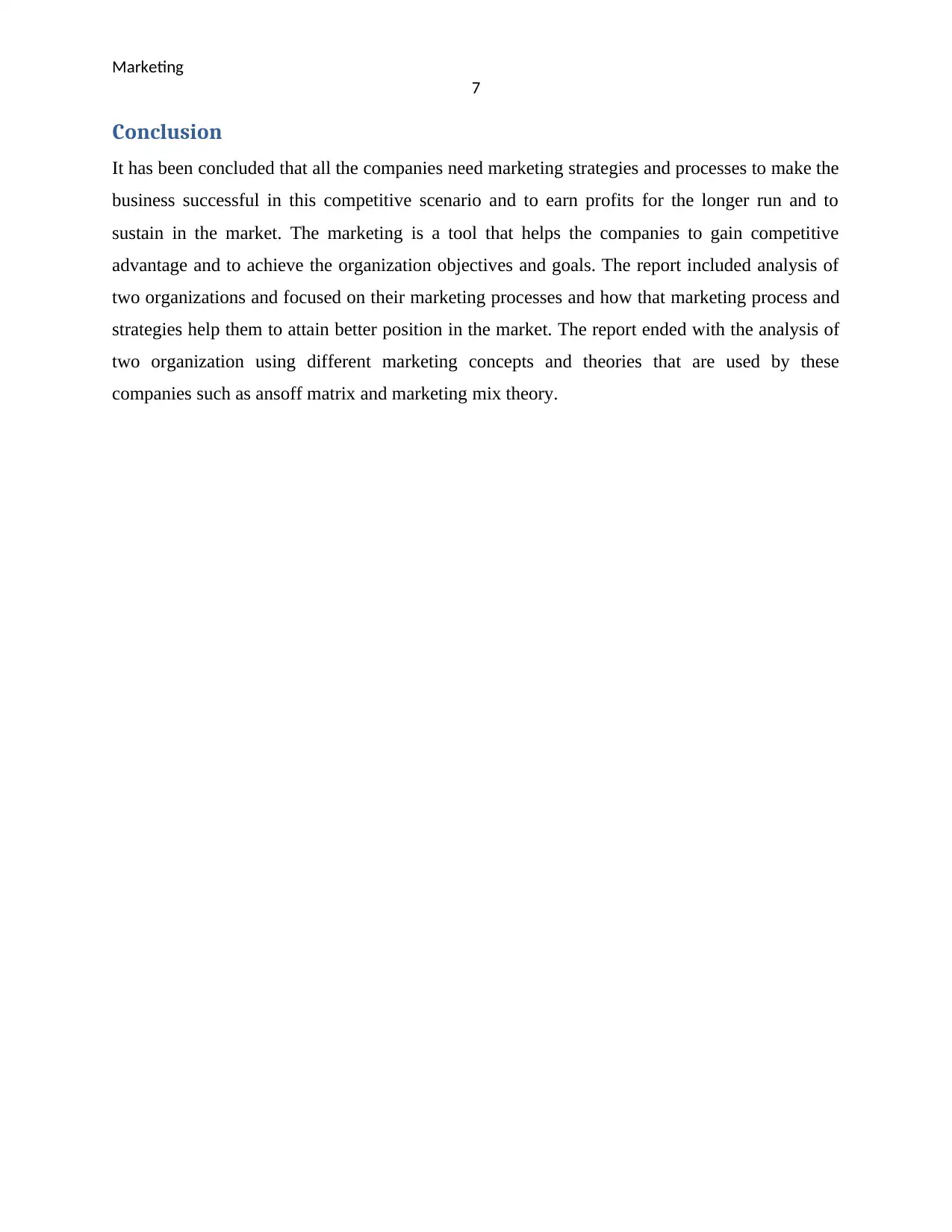
Marketing
7
Conclusion
It has been concluded that all the companies need marketing strategies and processes to make the
business successful in this competitive scenario and to earn profits for the longer run and to
sustain in the market. The marketing is a tool that helps the companies to gain competitive
advantage and to achieve the organization objectives and goals. The report included analysis of
two organizations and focused on their marketing processes and how that marketing process and
strategies help them to attain better position in the market. The report ended with the analysis of
two organization using different marketing concepts and theories that are used by these
companies such as ansoff matrix and marketing mix theory.
7
Conclusion
It has been concluded that all the companies need marketing strategies and processes to make the
business successful in this competitive scenario and to earn profits for the longer run and to
sustain in the market. The marketing is a tool that helps the companies to gain competitive
advantage and to achieve the organization objectives and goals. The report included analysis of
two organizations and focused on their marketing processes and how that marketing process and
strategies help them to attain better position in the market. The report ended with the analysis of
two organization using different marketing concepts and theories that are used by these
companies such as ansoff matrix and marketing mix theory.
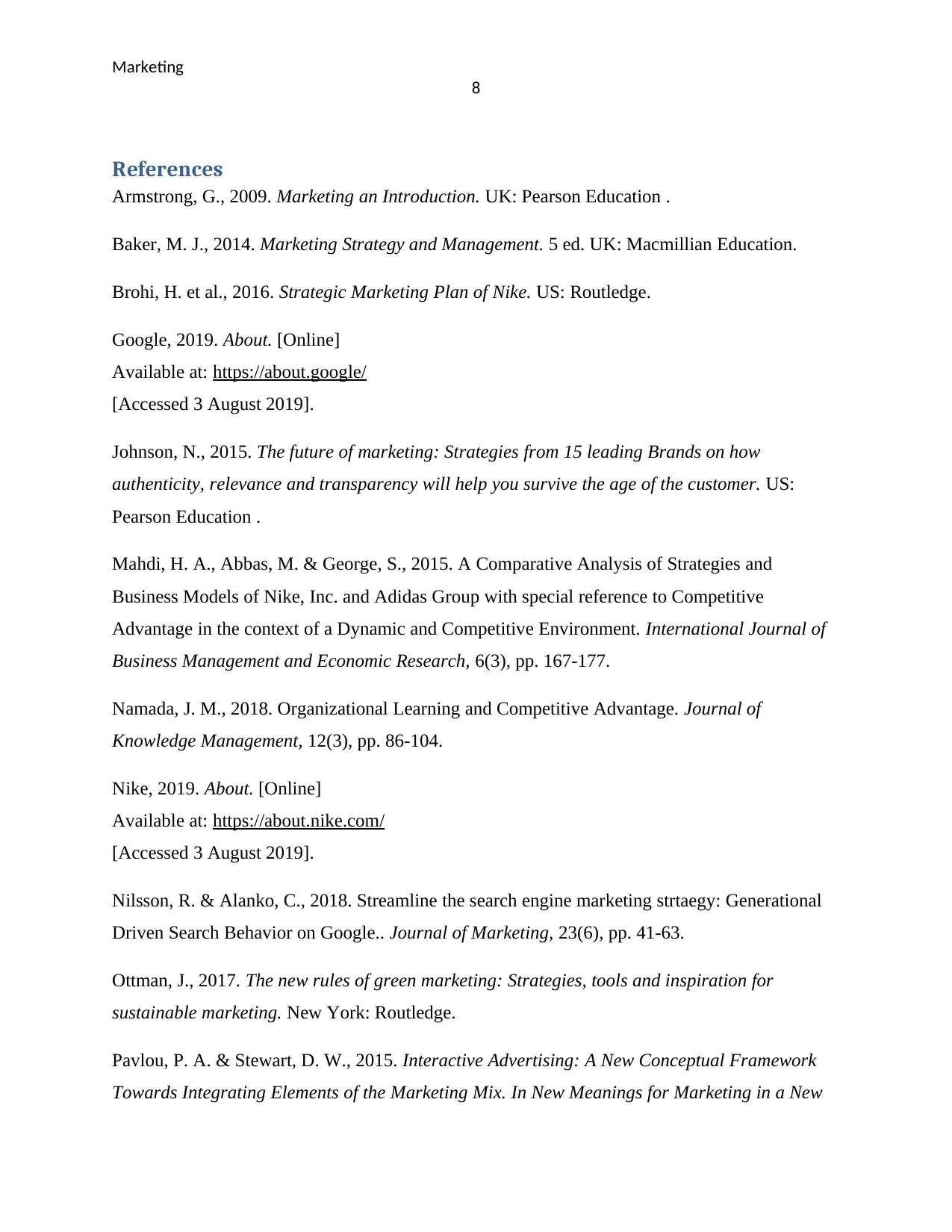
Marketing
8
References
Armstrong, G., 2009. Marketing an Introduction. UK: Pearson Education .
Baker, M. J., 2014. Marketing Strategy and Management. 5 ed. UK: Macmillian Education.
Brohi, H. et al., 2016. Strategic Marketing Plan of Nike. US: Routledge.
Google, 2019. About. [Online]
Available at: https://about.google/
[Accessed 3 August 2019].
Johnson, N., 2015. The future of marketing: Strategies from 15 leading Brands on how
authenticity, relevance and transparency will help you survive the age of the customer. US:
Pearson Education .
Mahdi, H. A., Abbas, M. & George, S., 2015. A Comparative Analysis of Strategies and
Business Models of Nike, Inc. and Adidas Group with special reference to Competitive
Advantage in the context of a Dynamic and Competitive Environment. International Journal of
Business Management and Economic Research, 6(3), pp. 167-177.
Namada, J. M., 2018. Organizational Learning and Competitive Advantage. Journal of
Knowledge Management, 12(3), pp. 86-104.
Nike, 2019. About. [Online]
Available at: https://about.nike.com/
[Accessed 3 August 2019].
Nilsson, R. & Alanko, C., 2018. Streamline the search engine marketing strtaegy: Generational
Driven Search Behavior on Google.. Journal of Marketing, 23(6), pp. 41-63.
Ottman, J., 2017. The new rules of green marketing: Strategies, tools and inspiration for
sustainable marketing. New York: Routledge.
Pavlou, P. A. & Stewart, D. W., 2015. Interactive Advertising: A New Conceptual Framework
Towards Integrating Elements of the Marketing Mix. In New Meanings for Marketing in a New
8
References
Armstrong, G., 2009. Marketing an Introduction. UK: Pearson Education .
Baker, M. J., 2014. Marketing Strategy and Management. 5 ed. UK: Macmillian Education.
Brohi, H. et al., 2016. Strategic Marketing Plan of Nike. US: Routledge.
Google, 2019. About. [Online]
Available at: https://about.google/
[Accessed 3 August 2019].
Johnson, N., 2015. The future of marketing: Strategies from 15 leading Brands on how
authenticity, relevance and transparency will help you survive the age of the customer. US:
Pearson Education .
Mahdi, H. A., Abbas, M. & George, S., 2015. A Comparative Analysis of Strategies and
Business Models of Nike, Inc. and Adidas Group with special reference to Competitive
Advantage in the context of a Dynamic and Competitive Environment. International Journal of
Business Management and Economic Research, 6(3), pp. 167-177.
Namada, J. M., 2018. Organizational Learning and Competitive Advantage. Journal of
Knowledge Management, 12(3), pp. 86-104.
Nike, 2019. About. [Online]
Available at: https://about.nike.com/
[Accessed 3 August 2019].
Nilsson, R. & Alanko, C., 2018. Streamline the search engine marketing strtaegy: Generational
Driven Search Behavior on Google.. Journal of Marketing, 23(6), pp. 41-63.
Ottman, J., 2017. The new rules of green marketing: Strategies, tools and inspiration for
sustainable marketing. New York: Routledge.
Pavlou, P. A. & Stewart, D. W., 2015. Interactive Advertising: A New Conceptual Framework
Towards Integrating Elements of the Marketing Mix. In New Meanings for Marketing in a New
⊘ This is a preview!⊘
Do you want full access?
Subscribe today to unlock all pages.

Trusted by 1+ million students worldwide
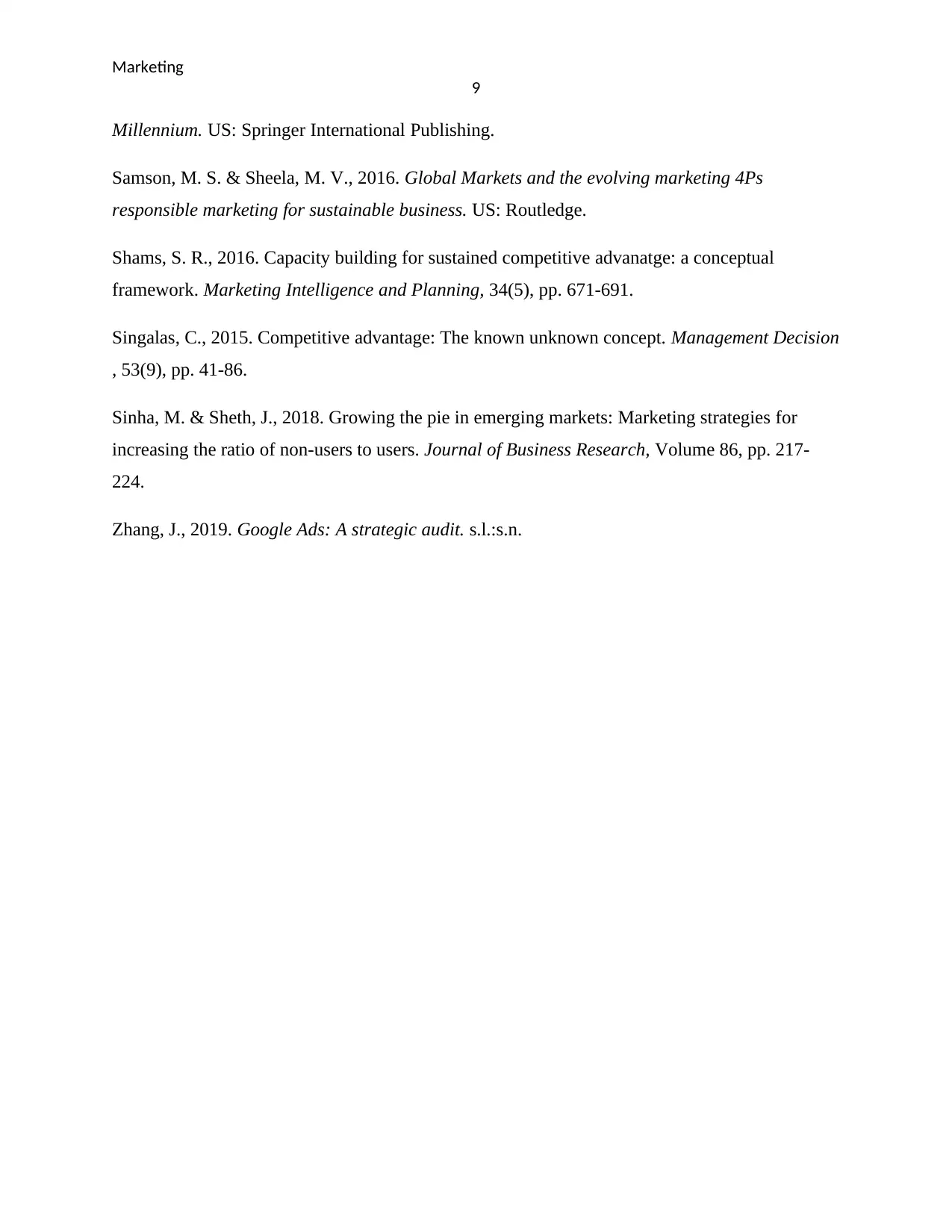
Marketing
9
Millennium. US: Springer International Publishing.
Samson, M. S. & Sheela, M. V., 2016. Global Markets and the evolving marketing 4Ps
responsible marketing for sustainable business. US: Routledge.
Shams, S. R., 2016. Capacity building for sustained competitive advanatge: a conceptual
framework. Marketing Intelligence and Planning, 34(5), pp. 671-691.
Singalas, C., 2015. Competitive advantage: The known unknown concept. Management Decision
, 53(9), pp. 41-86.
Sinha, M. & Sheth, J., 2018. Growing the pie in emerging markets: Marketing strategies for
increasing the ratio of non-users to users. Journal of Business Research, Volume 86, pp. 217-
224.
Zhang, J., 2019. Google Ads: A strategic audit. s.l.:s.n.
9
Millennium. US: Springer International Publishing.
Samson, M. S. & Sheela, M. V., 2016. Global Markets and the evolving marketing 4Ps
responsible marketing for sustainable business. US: Routledge.
Shams, S. R., 2016. Capacity building for sustained competitive advanatge: a conceptual
framework. Marketing Intelligence and Planning, 34(5), pp. 671-691.
Singalas, C., 2015. Competitive advantage: The known unknown concept. Management Decision
, 53(9), pp. 41-86.
Sinha, M. & Sheth, J., 2018. Growing the pie in emerging markets: Marketing strategies for
increasing the ratio of non-users to users. Journal of Business Research, Volume 86, pp. 217-
224.
Zhang, J., 2019. Google Ads: A strategic audit. s.l.:s.n.
1 out of 10
Related Documents
Your All-in-One AI-Powered Toolkit for Academic Success.
+13062052269
info@desklib.com
Available 24*7 on WhatsApp / Email
![[object Object]](/_next/static/media/star-bottom.7253800d.svg)
Unlock your academic potential
Copyright © 2020–2025 A2Z Services. All Rights Reserved. Developed and managed by ZUCOL.





